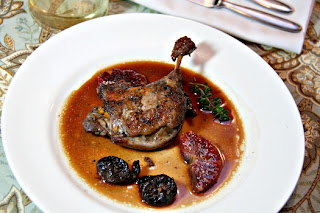
Blood oranges have a short season, and it's almost over. We have to eat them now.
With their striking color, aromatic rind, and complex, pleasantly bitter-sweet taste they make an excellent addition to savory dishes, like salads, sauces for meat and poultry, and one-pot braises.
Or, mix them with other citrus fruits and bake this colorful tart.
Here, the citrus fruits are not decorated in any way - they stand out and shine on their own. Use a mixture of Valencia and blood oranges, tangerines, Meyer lemons, or anything that's good at the farmers market.

In this simple preparation, the quality of the ingredients make a lot of difference. If you don't feel like making your own puff pastry dough (I know it's painful, I try to avoid making it too), use artisan all butter frozen puff pastry, like Dufour Classic, $11 at Whole foods. A more economical option is to get an artisan puff pastry dough for $4 at Trader Joes. It tastes great, but it doesn't puff up so readily, so the texture may get compromised.
I store a vanilla bean that my friends brought me from Bali in a jar of confectioners sugar, and use this gently perfumed sugar for baking. If vanilla sugar is not available, I wouldn't substitute artificial vanilla extract - too bold a flavor would distract from out main attraction, the citrus. Better skip vanilla and use plain sugar instead.

Mixed citrus tart
Makes 1 12x12 inch tart, serves 9
14 oz sheet frozen all butter puff pastry, defrosted
All-purpose flour, for dusting
4 oz Neufchatel cheese, or light cream cheese, at room temperature
1 egg, beaten
rind of 1 blood orange, grated
2 tsp vanilla sugar or confectioners sugar
5-6 mixed citrus fruits: oranges, tangerines, lemons
2 tsp confectioners sugar
On a floured surface, roll out the puff pastry dough to fit 12x12 square baking sheet. Trim the edges. Place the dough on a non-greased non-stick baking sheet. With a tip of a sharp knife, mark a 1/2-inch border around the perimeter of the tart, take care not to cut through the dough.
Reserve 1 Tbsp beaten egg for the egg wash. Combine the remaining egg, blood orange rind, Neufchatel cheese and vanilla sugar. Mix well.
Spread the cheese mixture in a thin layer over the dough, within the marked border.
Cut top and bottom from each citrus fruit, to expose the flesh. Place the fruit on it's end on a cutting board. With a sharp knife, cut off rind and the white pith in strips, turning the fruit. Slice the fruit into 1/4 thick slices, removing the seeds as you go.
Arrange citrus slices on the cheese mixture, making an attractive pattern. Sprinkle with sugar.
Make egg wash: mix 1 Tbsp beaten egg with 1 Tbsp water. Brush on the tart border.
Freeze tart for 30 minutes.
Preheat oven to 375 degrees (350 with convection). Bake the tart until the border is puffed up and browned, about 30 minutes.
- Posted using BlogPress from my iPad
























